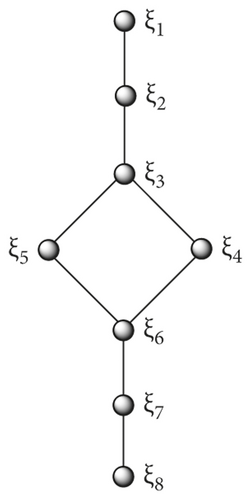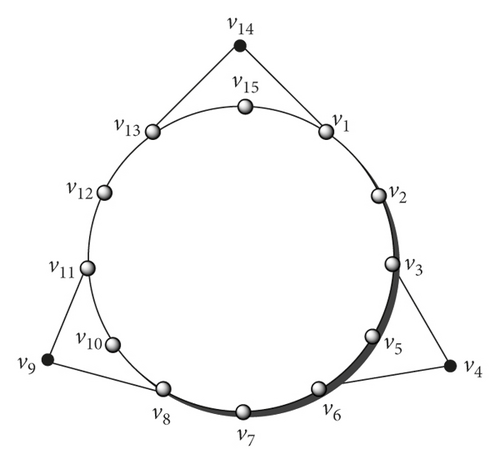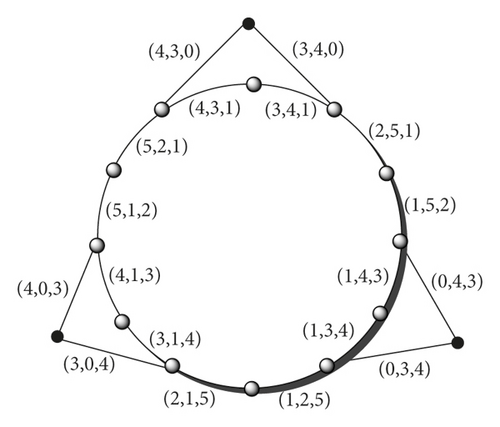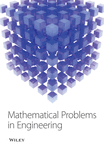Stepwise Irregular Graphs and Their Metric-Based Resolvability Parameters
Abstract
If the degrees of any two consecutive vertices differ by exactly one, the graph is called a stepwise irregular graph. The study of choosing specific vertices in an ordered subset of the vertex set such that no two vertices have the same representations with regard to the chosen subset is known as resolving parameters. This concept has been expanded for edges as well as a combined version of both. We examine a unique unicyclic stepwise irregular graph and an extended structure of stepwise irregular graph in terms of resolvability parameters to connect the stepwise irregular graph and resolving parameter concepts.
1. Introduction
Let λ be a simple, connected, undirected graph with V as the vertex set and E as the edge set. The degree of a vertex x ∈ V, which is the count of edges related to a, is denoted by χ(x). If every vertex in V has the same χ(x), the graph belongs to a regular class of graphs; otherwise, it is irregular. Regular graphs have a history that may be traced back to either theoretical or practical applications.
Researchers of [6] proposed the concept of metric dimension, which was based on the idea of identifying the location of invaders in networks first and foremost and called the metric generators as locating sets. The idea of metric dimension for trees is defined in [6] and for any graph in [7]. The resolving sets are also known as metric generators, using a similar technique. Radar or loran terminals were classified as components of the metric base set. If a single station fails to work, then the entire set ℵ resulted in failures to serve as a station hub. To overcome this problem, in 2008, the authors of [8] proposed an idea of a fault-tolerant resolving set. The idea of the adjacency generator was established in [9]; it was introduced to explain the metric dimension of composition of two networks.
Putting natural thinking on the pattern of recognizing the vertices of a graph by a subset (resolving set) of the vertex set, the edge metric dimension defined in [10], and later analogous to this definition, the authors of [11] proposed a mixed metric dimension in which both concepts (recognising vertices and edges) are combined, with the additional condition that no two elements (vertices and edges) have the same distances with respect to a chosen subset.
For η1, η2 ∈ V, the distance (also called as geodesics) d(η1, η2) between vertices η1 and η2 is the count of edges between η1 and η2. Let η ∈ V be a vertex for distinguished two vertices η1 and η2, if d(η, η1) ≠ d(η, η2). A set ℵ ⊂ V is called a resolving set for λ, if any pair of distinct vertices of λ is uniquely determined by some vertices of ℵ. The minimum cardinality of ℵ is named as a resolving set, and its cardinality is the metric dimension of λ, denoted by dim(λ) . If for each u ∈ ℵf, ℵf\u remains a resolving set for λ, then ℵf is named as a fault-tolerant resolving set and the minimum count of elements of ℵf is called as a fault-tolerant metric dimension. For a vertex η and an edge e = η1η2, the distance between η and e is measured as d(e, η) = min{d(η1, η), d(η2, η)}. A vertex η ∈ V identifies two edges e1, e2 ∈ E, if d(η, e1) ≠ d(η, e2). A subset ℵe having minimum vertices from a graph λ is an edge resolving set for λ, if each pair of two distinct edges of λ are distinguished by some vertex of ℵe. The minimum cardinality of an edge resolving set for a graph λ is called the edge metric dimension and is denoted by dime(λ). A vertex η of a graph λ distinguishes two elements (vertices or edges) η1, η2 of λ, if d(η1, η) ≠ d(η2, η). A subset ℵm is a mixed resolving set, if any vertex and edge of λ are distinguished by some vertex of ℵm. The smallest cardinality of a mixed resolving set for λ is called the mixed metric dimension and is denoted by dimm(λ). Moreover, the mixed metric dimension is a blended version of metric and edge metric dimension.
Computational complexity and NP hardness of the metric dimension problem was discussed in [12, 13]. The metric dimension has a range of useful uses in our everyday lives, which motivates scholars to study it. The metric dimension is extensively used in the varied fields such as combinatorial optimization [14], pharmaceutical chemistry [15], robot navigation [16], sonar and coastguard loran, facility location problems, image processing [6] weighing problems [17], and computer networks [18]; for more practical applications, see the literature [19, 20].
The concept of metric dimension has a wide range of applications due to its versatility and also its generalizations which are edge, fault-tolerant, and mixed metric dimension are widely used to solve many difficult problems. The study of metric dimension on some cycle-based graphs are discussed in [21]. The preprint on the application of metric dimension and its algorithm is available at [22]. The metric dimension of chemical structures are discussed in [23]. The upper bounds for some chemical networks, one can find at [24]. The metric dimension and its related parameters are discussed in [25]. Generalized classes of some basic graphs are discussed in [26]. For the recent work on the computer 3D network ,we refer to [27]. For a detailed study on these parameters of metric dimensions, see [28]. The fault-tolerance of chemical topologies are discussed in [29]. The generalized resolving set for the circulant graph is available at [30, 31]. The famous convex structure’s resolving set can be seen at [32, 33]. The fault-tolerant of some computer networks are available at [34]. Some rotationally symmetric, extremal structures, and generalized Peterson graph are discussed in [35–37]. For the edge metric of polytopes structure, we refer to [38]. Th seminal works on edge and mixed metric are available at [10, 11]. All the resolvability parameters of graph theory on the polycyclic aromatic hydrocarbons are discussed in [39]. For the recent study of stepwise irregular graph, we refer to [40–43] and some important applications of irregular graphs and their measures [44–46]. For some topological work on this topic, one can find it in [47, 48].
Following are some important results which are very helpful to prove our main work.
Theorem 1. Reference [11]: Let dim(λ) and dimf(λ) be the metric and fault-tolerant metric dimension of graph λ, respectively. Then,
Theorem 2. Reference [11]: If λ is a simple connected graph; then, dimm(λ) ≥ max{dim(λ), dime(λ)}.
Theorem 3. Reference [15]: If λ is a simple, undirected connected graph; then, (1) dim(λ) = 1 if λ = Pn.
Theorem 4. Reference [10]: For integers n, r, t ≥ 2, dime(Pn) = 1, dime(Cn) = 2, and dime(Kn) = n − 1. Moreover, dime(λ) = 1 if λ is a path Pn.
Theorem 5. Reference [11]: If λ is a graph with order |λ|; then, dimm(λ) = 2 if λ is a path.
Figure 1 is the stepwise irregular unicyclic graphs having a minimum number of vertices and the maximum degree of a vertex is Δ = 3 and due to equal order and size, its cyclomatic number is γ = 1. It is the only graph having γ = 1 with even order and size. It is a unique graph in terms of even order of a stepwise irregular unicyclic graph [5]. To check the resolvability of the stepwise irregular graph, we consider this the minimum order and a special graph. The following lemmas start the discussion of the resolvability of the stepwise irregular graph.

Lemma 1. If G1 is a unicyclic stepwise irregular graph with order 8, then
Proof. To prove that dim(G1) = 2, we will use the double inequality method. Let dim(G1) ≤ 2 and the resolving set ℵ = {ξ1, ξ4}. In Table 1, we provide with regard to ℵ, the representations of whole vertex set are given as follows:
Since the representations in the above table are distinct and there are no two vertices with same representations, we can say that dim(G1) ≤ 2.
On the contrary, let dim(G1) = 1. By Theorem.3, it is not possible, which concludes that the stepwise irregular graph in Figure 1 with
| r(ξi|ℵ) | r(ξi|ξ1) | r(ξi|ξ4) |
|---|---|---|
| r(ξ1|ℵ) | 0 | 3 |
| r(ξ2|ℵ) | 1 | 2 |
| r(ξ3|ℵ) | 2 | 1 |
| r(ξ4|ℵ) | 3 | 0 |
| r(ξ5|ℵ) | 4 | 1 |
| r(ξ6|ℵ) | 3 | 2 |
| r(ξ7|ℵ) | 5 | 2 |
| r(ξ8|ℵ) | 6 | 3 |
Lemma 2. Let G1 be a unicyclic stepwise irregular graph with order 8. Then,
Proof. On the contrary to prove that dimf(G1) = 3, first we will show that dimf(G1) ≤ 3 and the fault-tolerant resolving set ℵf = {ξ2} ∪ ℵ. In Table 2, we provide with regard to ℵf, the representations of whole vertex set are given as follows:
Since, the representations in the above table are distinct and there are two vertices with same representations, we can say that dimf(G1) ≤ 3.
On contrary to prove that dimf(G1) ≥ 3 we resulted to dimf(G1) = 2 which is not possible by Theorem 1. It proves that the stepwise irregular graph that is defined in Figure 1 has
| r(ξi|ℵf) | r(ξi|ξ1) | r(ξi|ξ2) | r(ξi|ξ4) |
|---|---|---|---|
| r(ξ1|ℵf) | 0 | 1 | 3 |
| r(ξ2|ℵf) | 1 | 0 | 2 |
| r(ξ3|ℵf) | 2 | 1 | 1 |
| r(ξ4|ℵf) | 3 | 2 | 0 |
| r(ξ5|ℵf) | 4 | 3 | 1 |
| r(ξ6|ℵf) | 3 | 2 | 2 |
| r(ξ7|ℵf) | 5 | 4 | 2 |
| r(ξ8|ℵf) | 6 | 5 | 3 |
Lemma 3. Let G1 be a unicyclic stepwise irregular graph with order 8. Then,
Proof. On the contrary to prove that dime(G1) = 2, let dime(G1) ≤ 2, and the edge resolving set ℵe = ℵ. In Table 3, we provide with regard to ℵe, the representations of whole edge set are given as follows:
Since, the representations in the above table are distinct and we cannot see any two edges with same representations, we can say that dime(G1) ≤ 2.
Now, to prove the reverse inequality, dime(G1) ≥ 2 on contrary dime(G1) = 1 and it is not possible by Theorem 1. It is concluded that the stepwise irregular graph in Figure 1 with
| r(ξiξj|ℵe) | r(ξiξj|ξ1) | r(ξiξj|ξ4) |
|---|---|---|
| r(ξ1ξ2|ℵe) | 0 | 2 |
| r(ξ2ξ3|ℵe) | 1 | 1 |
| r(ξ3ξ4|ℵe) | 2 | 0 |
| r(ξ3ξ6|ℵe) | 2 | 1 |
| r(ξ4ξ5|ℵe) | 3 | 0 |
| r(ξ5ξ6|ℵe) | 3 | 1 |
| r(ξ5ξ7|ℵe) | 4 | 1 |
| r(ξ7ξ8|ℵe) | 5 | 2 |
Lemma 4. Let G1 be a unicyclic stepwise irregular graph with order 8. Then
Proof. On the contrary to prove that dimm(G1) = 3, let dimm(G1) ≤ 3, and the mixed metric resolving set ℵm = {ξ8} ∪ ℵ. In Table 4, we provide with regard to ℵm, the representations of whole edge and vertex sets are given as follows:
Since, the representations in Table 4 are distinct and we cannot see any two components of the graph with same representations, we can say that dimm(G1) ≤ 3.
Now, to prove reverse inequality dimm(G1) ≥ 3, on contrary dimm(G1) = 2 which is not possible by Theorem 5.
It is concluded that the stepwise irregular graph in Figure 1 with
| r(ξi|ℵm) | r(ξi|ξ1) | r(ξi|ξ4) | r(ξi|ξ8) |
|---|---|---|---|
| r(ξ1|ℵm) | 0 | 3 | 6 |
| r(ξ2|ℵm) | 1 | 2 | 5 |
| r(ξ3|ℵm) | 2 | 1 | 4 |
| r(ξ4|ℵm) | 3 | 0 | 3 |
| r(ξ5|ℵm) | 4 | 1 | 2 |
| r(ξ6|ℵm) | 3 | 2 | 3 |
| r(ξ7|ℵm) | 5 | 2 | 1 |
| r(ξ8|ℵm) | 6 | 3 | 0 |
| r(ξiξj|ℵm) | r(ξiξj|ξ1) | r(ξiξj|ξ4) | r(ξiξj|ξ8) |
| r(ξ1ξ2|ℵm) | 0 | 2 | 5 |
| r(ξ2ξ3|ℵm) | 1 | 1 | 4 |
| r(ξ3ξ4|ℵm) | 2 | 0 | 3 |
| r(ξ3ξ6|ℵm) | 2 | 1 | 3 |
| r(ξ4ξ5|ℵm) | 3 | 0 | 2 |
| r(ξ5ξ6|ℵm) | 3 | 1 | 2 |
| r(ξ5ξ7|ℵm) | 4 | 1 | 1 |
| r(ξ7ξ8|ℵm) | 5 | 2 | 0 |
The graph shown in Figure 2 is the stepwise irregular graph with order 5β and size 6β. Its cyclomatic number is γ = 6β − 5β + 1 = β + 1. As shown in Figure 3, if we use β = 3, it create three cycles with order 4 and one cycle with order 4β and it adds up to 3 + 1 = 4-cycles in a graph. In the following sections, we discuss different resolvability parameters of the stepwise irregular graph such as resolving of vertices (metric dimension) or edges (edge metric dimension) and also resolving of vertices along edges (mixed metric dimension). Moreover, the updated version of the resolving set, which is a fault-tolerant resolving set, is also discussed.


2. Metric Dimension of a Stepwise Irregular Graph
This section refers to the resolving of vertices and computation of metric dimension of stepwise irregular graph .
Theorem 6. Let be a stepwise irregular graph with β = 3. Then,
Proof 5. To prove that when β = 3, we assume a resolving set ℵ = {v4, v9, v14}. On the vertex set of , we build the following examples:
From this representation, we obtain , that shows all the vertices of have unique representations with respect to resolving set ℵ.
For reverse inequality which is , by contradiction, it becomes . Following are some discussion for this claim.
Case 1. Consider the resolving set with ϕ = {v1, vi} where i = 2,3, …, 15, then the same representations are either in r(v4|ϕ) = r(v5|ϕ) or r(v9|ϕ) = r(v10|ϕ).
Case 2. Consider the resolving set ϕ = {vi, vj} where i = 2,3, j = 2,3, …, 15 and i ≠ j, then the same representations are either in r(v4|ϕ) = r(v5|ϕ) or r(v9|ϕ) = r(v10|ϕ).
Case 3. By assuming the resolving set ϕ = {vi, vj} where i, j = 4,5, …, 15 and i ≠ j, then the same representations are either in r(v4|ϕ) = r(v5|ϕ) or r(v9|ϕ) = r(v10|ϕ) or r(v14|ϕ) = r(v15|ϕ).
All discussion resulting in same representations of vertices. Hence, for β = 3,
Theorem 7. Let be a stepwise irregular graph with β ≥ 3. Then,
Proof. Assume that the resolving set ℵ = {vi+4 : i ≡ 0(mod5)}, |ℵ| = β. To show that , the induction will be applied to β the number of copies of the C4 graph. Assume that the assumption is valid for β = α and that the base case is β = 3, as demonstrated in Theorem 6.
We will prove that it is true for β = α + 1. We assume the following:
Then, by using (13) and (15) in (16), we will obtain the following:
Hence, it is true for all positive values of β ≥ 3
3. Fault-Tolerant Metric Dimension of
This section refers to the resolving of vertices with possibility of choosing one vertex extra for the replacement of faulty vertex in resolving set and also the computation of fault-tolerant metric dimension of stepwise irregular graph .
Theorem 7. Let be a stepwise irregular graph with β = 3. Then,
Proof. To prove that when β = 3, we assume a fault-tolerant resolving set ℵf = {v1, v4, v9, v14}. We construct the following cases on vertex set of
As a result of the preceding reasoning in the form of representations that , all the vertices of have unique representations with respect to fault-tolerant resolving set ℵf.
For , our claim becomes contradictory as a result of the conflict which is not possible by Theorem 1. Hence, for β = 3,
Theorem 8. Let be a stepwise irregular graph with β ≥ 3. Then,
Proof. The fault-tolerant resolving set ℵf = {v1} ∪ ℵ. Now to show that , the induction will be applied to β the number of copies of the C4 graph. We assume that the assumption is valid for β = α and that the base case is β = 3, as demonstrated in Theorem 7.
We will show that it is true for β = α + 1. Suppose
Using (19) and (22) in (23), we obtain the following:
Hence, it is true for all positive values of β ≥ 3
4. Edge Metric Dimension of
This section refers to the resolving of edges of stepwise irregular graph ; it also for the computation of edge metric dimension of that graph.
Theorem 9. If be a stepwise irregular graph of order 5β, then
for β = 3.
Proof. To prove that when β = 3, we assume an edge resolving set ℵe = {v4, v9, v14}. We can see edge representations in Figure 2 and it has a distinct representation with respect to edge metric resolving set ℵe.
Hence, it follows that because all the edges of have unique representations with respect to edge resolving set ℵe.
For , our claim becomes contradictory as a result of the conflict . Following are some cases for this claim.
Case 4. Consider the edge resolving set with 2-cardinality where i = 2,3, …, 15, then the same representations are either in or .
Case 5. Consider the edge resolving set again with 2-cardinality where i, j = 2,3, …, 15 and i ≠ j, then the same representations are either in or . All the cases resulted in contradiction, so this concludes that when β = 3,
Theorem 10. If is a stepwise irregular graph of order 5β, then
for β ≥ 3.
Proof. The vertex and edge resolving set have similar vertices and same cardinality so that ℵe = ℵ. To show that , the induction will be applied to β the number of copies of the C4 graph. Assuming that the assumption is valid for β = α and that the base case is β = 3, as demonstrated in Theorem 9,
We will show that it is true for β = α + 1. Suppose
Then, by using (26) and (28) in (29), we obtain the following:
Hence, it is true for all positive values of β ≥ 3.
5. Mixed Metric Dimension of
The mixed version of vertex and edge resolving is the mixed metric resolvability parameter. This section deals with resolving vertices as well as edges at a time.
Theorem 11. Let be a stepwise irregular graph with β = 3. Then,
Proof. To prove that when β = 3, we assume a mixed metric resolving set ℵm = {v4, v9, v14}. We can see vertex representations from Theorem 6 and edge representations from Figure 3 which are showing that every vertex and edge has a distinct representation with respect to mixed metric resolving set ℵm.
Hence, it follows that , because all the vertices and edges of have unique representations with respect to mixed metric resolving set ℵm.
For , our claim becomes contradictory as a result of the conflict which is not possible by Theorem 2. So, all discussion concludes that when β = 3,
Theorem 12. Let be a stepwise irregular graph with β ≥ 3. Then,
Proof. The mixed metric resolving set is same as the vertex resolving set and edge resolving set with same cardinality so that ℵm = ℵ. To show that , the induction will be applied to β the number of copies of the C4 graph. We assume that the assumption is valid for β = α and that the base case is β = 3, as demonstrated in Theorem 11.
We will show that it is true for β = α + 1. Suppose
Using (32) and (34) in (35), we obtain
Hence, it is true for all positive values of β ≥ 3.
Figure 2 is the stepwise irregular graph with β = 3, the labeling of vertices can be extended similarly to define in the figure and β can be any natural number greater than 2. Moreover, the dark black vertices show the vertex, edge, and mixed metric resolving set when β = 3 and the position of resolving set vertices remains the same while increasing the number of copies of β’s.
6. Conclusion
Recently, the generalized class of graphs known as stepwise irregular graphs was introduced. In this research, we initiate to discuss the resolvability parameters of this new type of graphs. One of the generalized stepwise irregular graphs is as shown in Figure 3. Each resolving parameter of is not constant, the cardinality of each resolving parameter (ℵ, ℵf, ℵe, ℵm) increases with increasing graph’s cyclomatic number which is γ = β + 1. As we have seen that the resolving parameters are also dependent on the degree of vertices of a graph and the stepwise irregular class of graphs is purely dependent on the degree of vertices, so the discussion of resolvability parameters of stepwise irregular graphs is interesting and opens the way of thinking on either stepwise irregular graphs or resolvability parameters of graphs. To extend this idea, we provide the following open problems at the end of this work. [50, 51].
Open problem 1. Do all the stepwise irregular graphs have varying resolving parameters (ℵ, ℵf, ℵe, ℵm) ?
Open problem 2. Is there any class of stepwise irregular graph with constant resolving parameters( (ℵ, ℵf, ℵe, ℵm) ?
Conflicts of Interest
The authors declare that they have no conflicts of interest.
Open Research
Data Availability
There are no data associated with this paper.




